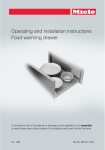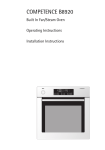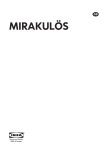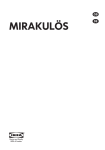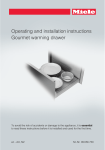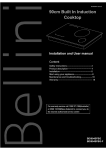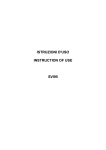Download LG LB621120S
Transcript
Built In Oven Operating Instructions LB621120S LB621100S Please read this instruction manual carefully before using the oven. This will ensure that you know the important safety information and the correct operation of the oven. Please keep this manual in a easily accessible place and refer to them anytime. Please transfer this manual to new owner if you sell the oven. P/No. :MFL30374515 표2는 백지 Foreword Dear Customer, You have purchased a high-quality appliance from our Company. Thank you for your purchase. To ensure many years of pleasure in the use of your oven, and to familiarise yourself with all of the appliance's functions, please read through this Instruction Manual carefully. Please pay particular attention to the section containing safety instructions in the first few pages. Keep the Instruction Manual in a safe place for reference if questions should arise. If you should sell the appliance on, please pass the Instruction Manual on to the new owner. 3 Contents Safety ............................................................................... 6~10 Appliance description ..................................................... 11 Control panel ................................................................... 12~15 For model:LB621120S ................................................. 12~13 For model:LB621100S ................................................. 14~15 Accessories ..................................................................... 16 Telescopic slides (special accessory) .......................... 17 Before initial use ............................................................. 18 Setting the time of day (For model:LB621120S) ............ 18 Initial cleaning .................................................................. 19 Using the oven ................................................................ 20~33 Operating modes ............................................................ 20~22 Switching the oven on ..................................................... 23 Switching the oven off ..................................................... 24 Indicator (For model:LB621100S) ................................... 25 Clock functions and symbols (For model:LB621120S) ... 26 Setting the timers (For model:LB621120S) ..................... 27 Programming the overall cooking / baking time (For model:LB621120S) .................................................. 28 Programming the end of cooking / baking time (For model:LB621120S) .................................................. 29 Combining overall cooking / baking time and end of cooking / baking time (For model:LB621120S) ............................... 30~31 Setting the time of day (For model:LB621120S) ............. 32 Childproof safety device (For model:LB621120S)........... 33 Baking .............................................................................. 34~35 Baking table ..................................................................... 36~39 Roasting............................................................................ 40 Roasting table .................................................................. 41~42 4 Roasting table .................................................................. 41~42 Grilling............................................................................... 43~44 Grilling table ..................................................................... 44 Defrosting ......................................................................... 45 Defrosting table................................................................ 45 Test dishes as per 44547 ................................................. 46~47 Cleaning and care ........................................................... 48~51 Oven light ......................................................................... 52 Oven door ........................................................................ 53~59 Troubleshooting .............................................................. 60~61 Technical specifications.................................................. 62~63 Installation instructions................................................... 64 Customer service & spare parts .. .................................. 65 5 Safety • This oven must only be installed by a licensed electrician. • The installer is responsible for the correct electrical connection of the appliances and the observance of the relative safety recommendations. Electrical Safety If the oven has been damaged in transport, do not connect it. • This appliance must be connected to the mains power supply by a specially licensed electrician only. • In the event of a fault or damage to the appliance, do not attempt to operate it. • Repairs of the appliance should be carried out by a licensed technician only. Wrong repairs may result in considerable danger. If you need repairs, contact an LG Service Center or your dealer • If supply cord is damaged, it must be replaced by a special cord or assembly available from the manufacturer, its service agent. • Electrical leads and cables should not be allowed to touch the oven. • The oven should be connected to the electricity supply by means of a proper circuit breaker or fuse. Never use multiple plug adapters or extension leads. 6 • Rating plate is located on the left side of door and on the back cover. • The power supply of the appliance should be turned off when it is being repaired or cleaned. • Be careful in connecting electrical appliances to sockets near to this appliance. • This connection may be achieved by having the plug accessible or by incorporation a switch in the fixed wiring in accordance with the wiring rules. • Do not use harsh abrasive cleaners or sharp metal scrapers to clean the oven door glass since they can scratch the surface, which may result in shattering of the glass. Warning: The appliance should be powered down before replacing the lamp to avoid the possibility of electric shock. Warning: When the oven operates, the interior parts will be very hot. Warning: Accessible parts may become hot during use. Young children should be kept away. Warning: Accessible parts may become hot when the grill is in use. Children should be kept away. Warning: Please ensure cooking times are correctly set as over cooking may result in the food catching fire and subsequent damage to your oven. 7 Safety Safety during Operation • This oven has been designed only for the cooking of household foods. • When in use, the oven interior surfaces become very hot! Care should be taken to avoid touching heating elements inside the oven. • Never store flammable or easily deformable materials in the oven. • The oven surfaces will become hot when the appliance is operated at a high temperature for a long period of time. • Excess spillage should be removed before self cleaning and all utensils should not be left in the oven during pyrolytic selfcleaning. • During self cleaning the surfaces get hotter than usual and children should be kept at a safe distance. • When cooking, take care when openning the oven door as hot air and steam will escape rapidly. • When cooking dishes that contain alcohol, the alcohol can evaporate due to the high temperatures. The vapour can catch fire if it comes into contact with a hot oven part. • Do not use high-pressure water cleaners or steam jet cleaners for electrical safety reasons. 8 • Children should be kept at a safe distance when the oven operates. • Frozen foods such as pizzas should be cooked on the wire grill. If the Baking tray is used, it may become deformed due to the great difference in temperature. • Don’t pour water into the oven bottom when it is hot. This could cause damage to the enamel surfaces. • The oven door must be closed when cooking is performing. • Don’t spread aluminium foil on the bottom of the oven and do not place any baking trays or tins on it. The aluminium foil blocks the heat, which may result in damage to the enamel surfaces and cause poor cooking results. • Dripping fruit juices from the baking tray will leave stains, which become indelible. When cooking very moist cakes, use the deep pan. • Do not use the oven door as a rest table for hot or cold cookwares. • The appliance is not intended for use by young children or infirm persons without supervision. • Young children should be supervised to ensure that they do not play with the appliance. • Children should be kept at a safe distance until the oven has cooled down after cooking. • This appliance is not intended for use by persons (including children) with reduced physical, sensory or mental capabilities, or lack of experience and knowledge, unless they have been given supervision or instruction concerning use of the appliance by a person responsible for their safety. 9 Safety Disposal Packaging material • Your new oven has been correctly packaged for transportation. Remove all of the packaging material before putting the appliance into use. • The packaging material can be completely recycled. You can obtain addresses for environmentally-friendly disposal operations from your local authority. Used appliances Warning! • Used appliances must be rendered unusable prior to disposal so that they no longer present a risk. To achieve this, disconnect from the mains supply and remove the power supply cable. For the protection of the environment, used appliances must be disposed of properly. • The appliance must not be disposed of along with normal domestic waste. • Your local authority will inform you of times for uplifting special waste or identify public disposal facilities for you. 10 Appliance description Overview Control panel Top-heating and grill heating element Shelfsupport levels Oven light Level 5 Level 4 Level 3 Door seal Level 2 Level 1 Side shelf support Rating plate Glass door Door handle Oven levels are numbered from the bottom up. The 4 and 5 levels are mainly used for grill functions. The cooking tables throughout this operating instructions give you suggested oven level (shelf positions), however you can change these to suit yourself. 11 Control Panel For model:LB621120S 1 2 4 3 1. Timer button 2. Clock button 3. Operating mode knob 4. Time display 12 5 6 7 5. Less button 6. More button 7. Temperature knob 13 Control Panel For model:LB621100S 1 2 1. Function indicator 2. Operating mode knob 14 3 4 3. Heating Indicator 4. Temperature knob 15 Accessories Wire grill For dishes, baking tins, grilling and roasting tins. Deep pan For cakes and biscuits, for roasting and for catching roasting juices or fat. Hints on using the trays and shelves Ensure that the trays and shelves are properly fitted into the two side shelf 5 4 Wire grill supports. Take particular 3 care when removing 2 Deep pan finished dishes and meals 1 gap 2cm from the oven! Use suitable cloth pot holder or oven gloves. If you are using the wire grill in combination with the deep pan or some other tray to catch dripping liquids or fat, then do not put the trays down on the oven floor, but slide them into the shelf supports as well. If you place trays on the oven floor, the resulting build-up of heat can damage the surface of the oven. For this reason, there must always be a minimum gap of 2 cm between the accessories and the oven floor. With wire grill, always ensure that they are properly in position in the shelf supports. Fitting the wire grill and trays Slide the tray or shelf in at the desired level. The shelf support levels are numbered from the bottom up to the top. 5 4 3 2 1 16 Telescopic slides (special accessory) Installation The telescopic slides are installed as follows: 1. Put the inserting bar of the telescopic slide into the hole. 2. Align the front recess with the front screw hole. Turn a screw in and tighten both screws. Repeat the procedure for the second telescopic slide arm. 3. Trays and shelves must be placed on the telescopic slide arms with care so as to avoid any accidental tipping over. To prevent this, place trays and shelves on the telescopic slide arms as shown in the illustration below, so that the securing pins on the slide arm catch the tray or shelf to prevent any slipping. 17 Before initial use Setting the time of day (For model:LB621120S) The oven cannot be used until the time of day is set. When the appliance is connected for the first time or after a power failure, the time display flashes at "12:00". Example: to set the current time of day to 13:30. time display flashes at 1 The “12:00” and the egg timer the button(– / +) to 2 Press change the clock time symbol will blink. (13:30, in the example). The time will be set after 4 seconds. 18 Initial cleaning Clean the oven carefully before putting it into use. Important: Do not use any caustic or abrasive cleaners. These can damage the oven surfaces. Appliance front Ovens with a metal front must be cleaned with standard detergents only. Wipe the front of the appliance with a slightly damp cloth. Oven interior 1. Open the oven door. 2. Clean all baking trays, accessories and the side shelf supports with warm water and dishwashing liquid. 3. Clean the oven interior in the same way, using warm water and dishwashing liquid. 4. Allow the oven to dry. Heating up Before baking or roasting, heat up the oven, the first time it is switched on an unpleasant smell may arise. Open the windows and ensure there is adequate ventilation during this procedure. 1. Ensure that the time of day is set correctly. 2. Remove all accessories from the oven. 3. Use the knob to select the operating mode: 3D Hot Air( Convection grill( ) at 200°C (see next page). 4. Leave the oven on in this operating mode for one hour. 19 ) or Using the oven Operating modes Oven Light 3D hot air Defrosting Conventional heat Large grill Bottom heat Convection grill Description of operating modes The individual operating modes differ in that they involve a combination of different heating elements. The various combinations are suitable for producing a variety of heated areas and Convection circulation paths in the oven, as required for the optimum preparation of various dishes. When using the grill function( ), dial the temperature knob by on the grill mark. 20 Conventional heat For conventional heat, the heating elements above and below the baking chamber are used. This operating mode is suitable for baking cakes, baking with a short baking time, sensitive doughs and for roast beef and fillet of beef on the one level. The recommended temperature is 190°C. 3D hot air In addition to the conventional heat elements, 3D hot air mode uses the hot-air fan in the back wall. This means that the roasting and baking temperature can be reduced by 20-40°C. The recommended temperature is 150°C. This mode is suitable for cakes and biscuits, as it is possible to bake on more than one level at the same time. Convection grill In this mode, the grill heating elements are used with the hot-air fan. The recommended temperature is 190°C. This function is suitable for pizzas, quiche lorraine or cheesecakes. Bottom heat In bottom heat mode, only the heating element in the oven floor is used. The recommended temperature is 170°C. This function is particularly suitable for finishing off cakes or pizzas supposed to have a crispy base, on one of the shelf support levels. 21 Using the oven Large grill The large grill( ) uses the entire heating element. When using this function, dial the temperature knob by on the grill mark( ). The large grill ( ) is suitable for cooking steaks, cutlets, fish or making toast, and when cooking larger quantities for browning or with a gratin topping. Defrosting In defrosting mode, the fan is used without heating. The circulating air speeds up the defrosting process. Place the frozen food in a suitable container to trap the liquid produced during defrosting. Where appropriate, you can use the wire grill and the deep pan to avoid soiling the oven. If water is allowed to run out into the oven, the door seals will be contaminated and an unpleasant odour may result. 22 Using the oven Switching the oven on the desired mode 1 Select with the Operating mode the desired oven 2 Select temperature. knob. setting the oven 3 After temperature, the oven will start immediately. 23 Using the oven Switching the oven off Set the Operating mode knob to "O" to switch the oven off. Oven fan When the oven is switched on, the fan is automatically activated to cool the oven surfaces. When the oven is switched off, the fan is also switched off. Thermal cut-out If the oven should overheat, the power supply to the heating elements is switched off for a period of time so as to avoid any damage to the appliance. Baking dishes When using baking dishes, always ensure that the dish is suitable for use at the temperature inside the oven. The oven can operate at up to 250°C. Refer to the instructions provided by the manufacturer of the dish. 24 Indicator (For model:LB621100S) Function Indicator Heating Indicator indicator is turned on in 1 This case a function is set. indicator is turned on 2 This only if one or more heating elements are working on. 25 Using the oven Clock functions and symbols (For model:LB621120S) End of cooking / baking time Hour Overall cooking / baking time display Childproof safety device Timer (timing clock) Minute display Clock Heating indicator Timer Lights up when the function timer is activated (e.g. like a minute minder when boiling eggs). Overall cooking time Lights up when the overall cooking time is being set or displayed. The oven switches off automatically after the cooking time set has expired. End of cooking time Lights up when the point in time set for the end of the cooking / baking time is set or displayed. The oven switches off automatically at the stipulated time. Heating indicator This indicator is turned on only if one or more heating elements are working on. Clock Lights up when the time is being set, changed or displayed. 26 Setting the timers (For model:LB621120S) 1 Press the timer( ) button. the desire time with the 2 Set More/Less(–/+) buttons. (30min. in the example) 4 seconds, the time 3 After will be set. And you will hear a signal tone. * Switching off the signal tone Press any button once to cancel the signal tone. 27 Using the oven Programming the overall cooking / baking time (For model:LB621120S) The oven switches off automatically at the end of the period of time entered. the desired operating 1 Select mode and temperature. the Clock button( 2 Press once. the desired overall 3 Set cooking/baking time with the 4 seconds, the time 4 After will be set. And you will hear More/Less(–/+) buttons. (30min. in the example) ) a signal tone. Once this time has expired you will hear a beep sound, and the oven will switch off automatically. Press any button once to cancel the audible sound. 28 Programming the end of cooking / baking time (For model:LB621120S) The oven switches off automatically at the time entered. the desired operating 1 Select mode and temperature. the Clock button( 2 Press twice. the desired end of 3 Set cooking/baking time with the 4 seconds, the time 4 After will be set. And you will hear More/Less buttons. (In the example, the current time is 13:30 and the dish is to be finished at 14:30) ) a signal tone. Once this time has expired you will hear a beep sound, and the oven will switch off automatically. Press any button once to cancel the audible sound. 29 Using the oven Combining overall cooking / baking time and end of cooking / baking time (For model:LB621120S) The overall and end of cooking time programmes can be combined to permit the oven to be switched on and off automatically. the desired operating 1 Select mode and temperature. the Clock button( 2 Press once. the desired overall 3 Set cooking/baking time with the press the Clock button 4 Now once to set the end of More/Less(–/+) buttons. (30min. in the example) cooking before starting. 30 ) the desired end of 5 Set cooking/baking time with the 4 seconds, the time 6 After will be set. And you will hear More/Less(–/+) buttons. (14:30, in the example) a signal tone. 30 minutes before the end of cooking/baking time, the oven switches on automatically, at 14:00 in the example shown. Once this time has expired you will hear a beep sound, and the oven will switch off automatically. Press any button once to cancel the audible sound. 31 Using the oven Setting the time of day (For model:LB621120S) the Clock button( 1 Press 3 times. ) the current time with the 2 Set More/Less(–/+) buttons. (11:30, in the example) 4 seconds, the time 3 After will be set. And you will hear a signal tone. 32 Childproof safety device (For model:LB621120S) The childproof safety device prevents the oven from being switched unintentionally. 1. Press the Clock button ( ). Hold it down for 4 seconds until the lock symbol( ) appears in the display. The childproof safety device is now activated. 2. To switch off the childproof safety device, press the Clock button ( ) until the lock symbol( ) is no longer displayed. The childproof safety device is now deactivated and the oven is ready for use. 33 Baking General information When baking, use the 3D hot air( modes. ) or conventional heat( ) Baking tins • When baking in conventional heat( ) modes, use baking tins with a dark metal or coated surface. • When baking with 3D hot air( ), you can also use baking tins with a bright metal surface. • Always place baking trays in the oven with the flat side to the front. • Always place cake tins in the middle of the tray or shelf. • When baking with 3D hot air( ) or conventional heat( ) , you can place two baking tins side by side in the oven. This means that the baking time is only slightly longer. Shelf levels The shelf levels are numbered from the bottom up. When cooking on multi-levels at the same time, accessories are properly fitted in the correct levels as below Level 2 : Deep pan Level 4 : Wire grill (If you have a similar-sized tray) Level 2 : Similar-sized tray Level 4 : Deep pan 34 4 2 Using baking tables The tables contain the temperature settings, baking time and shelf levels for a selection of typical dishes. • Temperatures and baking times should be regarded as reference figures only. The actual values depend on the type of preparation, quality of ingredients and the baking tin in use. • We recommend first selecting a lower temperature and then increasing it if necessary, for example if you want a higher degree of browning or the baking time is too long. • If you cannot work out the settings for a specific recipe, simply use the settings for the most similar recipe. • When baking cakes on baking trays or in tins on more than one level, the baking time may be extended by 10–15 minutes. • Baking with a high liquidity content (e.g. pizza, fruit cakes, etc.) should be baked on a single level only. • With cakes and baking with different levels of dough, uneven browning may take place initially. In this case do not alter the temperature setting. The degree of browning will even itself out over the baking process. NB: Over extended baking times, the oven may be switched off about 10 minutes before the end of baking time. Make use of the residual heat available. The times stated in the table apply only for an oven which has not been preheated. Preheating the oven reduces the time by about 10 minutes. 35 Baking table Baking Operating mode Recipe Cakes in baking tins Ring-shaped pound cake Biscuits / pancakes Sponge finger Flan base – shortcrust pastry Flan base – cake mixture Apple pie Spicy cakes and flan base (e.g. quiche lorraine) Cheesecake Cakes on baking tray Bread plaits / larger cakes Christmas stollen Bread (rye bread) initially, then later Pie / eclair Swiss roll Fruit cake with shortcrust pastry1 Baking time Shelf level Temp. in °C Shelf level Temp. in °C For both types of baking, in hrs, mins. 1 150–160 1 160–180 0:50–1:10 1 1 3 140–160 150–160 170–180 1 1 2 150–170 160–180 190–2101 1:10–1:30 0:25–0:40 0:10–0:25 3 150–170 2 170–190 0:20–0:25 1 1 150–170 160–180 1 1 170–190 190–210 0:50–1:00 0:30–1:10 1 140–160 1 170–190 1:00–1:30 3 160–170 3 170–190 0:30–0:40 3 1 150–1701 180–2001 140–160 160–1701 150–1701 160–170 3 2 160–1801 2301 160–180 190–210 180–2001 170–190 0:40–1:00 0:20 0:30–1:00 0:15–0:30 0:10–0:20 0:40–1:20 3 3 3 36 3 3 3 Operating mode Recipe Baking time Shelf level Temp. in °C Shelf level Slices with topping/ – – 3 filling, e.g. quark, cream, sugar, almonds Pizza (thick base) 180–200 1 1 Pizza (thin base) 200–220 1 1 Unleavened bread 200–220 1 1 Wähe (Swiss flan) 180–200 1 1 Biscuits Shortcrust biscuits 150–160 3 3 Iced biscuits 140–150 3 3 Cake mixture biscuits 150–160 3 3 Cakes and pastries 80–100 3 3 with egg white, meringues Macaroons 100–120 3 3 Yeast dough biscuits 160–170 3 3 Puff pastry cakes and 160–170 3 3 1 pastries –180 Bread rolls 3 180–2001 3 1) Preheat oven! Always count shelf levels from the bottom up! 37 For both types of baking, in hrs, mins. 160–1801 0:40–1:20 Temp. in °C 190–2101 2301 2301 210–230 0:30–1:00 0:10–0:25 0:08–0:15 0:35–0:50 170–1901 160–180 170–190 100–120 0:06–0:20 0:10–0:40 0:15–0:20 2:00–2:30 120–140 170–190 190–2101 0:30–0:60 0:20–0:40 0:20–0:30 180–2201 0:20–0:35 Baking table Table for strudel and baked dishes Baked pasta Lasagne Baked vegetables1 Pizza baguette1 Soufflé Fish pie Stuffed vegetables Shelf level 1 1 1 1 1 1 1 Temp. in °C 180–200 180–200 200–220 200–220 180–200 180–200 180–200 Baking time in hrs, mins. 0:45–1:00 0:25–0:40 0:15–0:30 0:15–0:30 0:15–0:30 0:30–1:00 0:30–1:00 1) Preheat oven! Always count shelf levels from the bottom up! Baking tables for frozen ready–made dishes Dish Frozen pizza Baguettes Fruit cake base Chips Shelf level 3 3 3 3 Oven function Temperature Time Follow instructions Follow instructions on pack. on pack. Follow instructions Follow instructions on pack. on pack. Follow instructions Follow instructions on pack. on pack. 200–220°C 15–25 mins. Always count shelf levels from the bottom up! NB: Turn chips 2 or 3 times when heating. When heating frozen dishes, the baking tray may bend out of shape because of the great difference in the temperature of the frozen food and the oven. Trays normally return to their original shape once they have cooled down. 38 Baking tips Results of baking The cake base is too light Cake collapses (turns lumpy, soggy) Possible cause Wrong shelf level Solution11 Use a dark baking tin or put the cake one level lower down. Oven temperature too Set the temperature slightly high lower. Baking time too short Set a longer baking time. The baking time cannot be reduced by setting a higher temperature. Mixture contains too Use less liquid. Follow much liquid instructions for dough mixing times, especially when using kitchen appliances. Cakes are too dry Oven temperature too Next time set a slightly higher low temperature. Baking time too long Set a slightly shorter baking time. Cakes are Baking temperature Set a slightly lower baking browned unevenly too high and baking temperature and a slightly time too short higher baking time. Distribute the mixture evenly Mixture unevenly over the baking tray/tin. distributed Next time set a slightly Baking time too Temperature too long higher temperature. low 39 Roasting When roasting, use the convection grill( modes. ), conventional heat( ) TIP: • Use heat resistant dishes when roasting (follow manufacturer's instructions). • Stainless steel roasting pans are only of limited use, as they reflect the heat to a very large extent. • When using dishes with plastic handles, ensure that the handles are heat resistant (follow manufacturer's instructions). • Large items for roasting or a number of items can be placed directly on the deep pan or on the shelf above the deep pan (e.g. turkey, goose, 3~4 chickens, 3~4 knuckles of veal). • Lean meat should be roasted in a roasting tray with a lid (e.g. veal, braised beef, deep frozen meat). This keeps the juices in the meat. • For cooking crispy crusts or bacon, a casserole with no lid should be used (e.g. pork, minced meat, lamb, mutton, duck, knuckle of veal, chicken, poultry meat, roast beef, fillet of beef, game birds). TIP: • Clean the oven as soon as possible after use if you are roasting in an open-topped tin. It is easier to remove fat splashes when the oven is still warm. WARNING Allow the oven to cool down enough to ensure there is no risk of burning yourself. 40 Roasting table The table contains the required temperatures, roasting times and shelf levels for various kinds of meat. The figures stated are approximate figures only. • We recommend cooking meat and fish weighing over 1 kg in the oven. • For lean meat and fish, use conventional heat. For all other kinds of meat we recommend convection grill( ) mode. • Add a little liquid to prevent roasting juices or fat from getting burned on. • Turn the joint over after about half or two thirds of the cooking time. TIP:For better roasting results, baste joints and poultry with their own juices a number of times during the roasting process. Switch off the oven 10 minutes before the end of cooking time. Make use of the residual heat available. Weight, size Shelf level Temp. in °C Shelf level Temp. in °C Cooking time in hrs, mins. 1–1.5 kg 2 200–230 – – 2:00–2:30 2.5cm thick 2.5cm thick 2.5cm thick 2 2 2 2301 2301 210–2301 2 2 2 190–200 0:05–0:06 180–190 0:06–0:08 170–180 0:08–0:10 1–1.5 kg 2 210–220 2 160–180 1:30–2:00 1–1.5 kg 750 g–1 kg 750 g–1 kg 2 2 2 180–190 170–180 210–220 2 2 2 170–180 1:00–1:30 160–170 0:45–1:00 150–170 1:30–2:00 Operating mode Type of meat Beef Pot roast Roast beef or fillet of beef – rare – pink – well done Pork Shoulder, neck, ham Chop, loin Pork roast Knuckle of pork (pre-cooked) 41 Roasting table Operating mode Type of meat Veal Veal roast Knuckle of veal Lamb Leg of lamb Lamb roast Saddle of lamb Game Roast hare, leg of hare Venison (saddle) Venison (leg, haunch) Poultry Poultry portions (4–6 pieces) Chicken halves (2–4 parts) Chicken, poularde Duck Goose Turkey Temp. in °C Cooking time in hrs, mins. Weight, size Shelf level Temp. in °C Shelf level 1 kg 1.5–2 kg 2 2 210–220 210–225 2 2 160–180 1:30–2:00 160–180 2:00–2:30 1–1.5 kg 2 210–220 2 150–170 1:15–2:00 1–1.5 kg 2 210–220 2 160–180 1:00–1:30 Up to 1 kg 3 220–2301 3 160–170 0:25–0:40 1.5–2 kg 1.5–2 kg 2 2 210–220 200–210 2 2 160–180 1:15–1:45 160–180 1:30–2:15 200–250 g each 400–500 g each 1–1.5 kg 3 220–230 3 180–200 0:35–0:50 3 220–230 3 180–200 0:35–0:50 2 220–230 2 170–180 0:45–1:15 1.5–2 kg 3.5–5 kg 2.5–3.5 kg 4–6 kg 2 2 2 210–220 200–210 200–210 180–200 2 2 2 160–180 150–160 150–160 140–150 1) Preheat oven! Always count the shelf levels from the bottom up! 42 1:00–1:30 2:30–3:00 1:30–2:00 2:30–4:00 Grilling For grilling, you have a choice of 2 different operating modes. Large grill For larger quantities of flat food for grilling, and for top-baking in large tins. Choose 1 of 3 power levels (1 low, 2 medium and 3 high), as suitable for the food being grilled. Convection grill For grilling larges pieces of meat or poultry, such as rolled roast or turkey, for example. NB: When grilling, the oven door must be kept closed at all times. As a basic principle, the oven should be preheated for 3 minutes! Grilling dishes Use the wire grill or the deep pan for grilling. Use the shelf for making toast. To catch dripping liquids, slide the deep pan in at Level 1 or 2. 43 Grilling Shelf levels Use Levels 4 or 5 for grilling flat pieces of meat. Warning note: exposed parts of the oven can become hot during grilling. Keep children at a distance. (Insert with corresponding programme, as appropriate.) Using the grilling table The grilling times are intended as approximate values only. The actual times may vary depending on the quality of the actual meat or fish. Grilling is particularly suitable for cooking flat pieces of meat and fish. Turn the grilled food over about halfway through the cooking time. Grilling table Food for grilling Shelf level Rissoles Pork fillet Grilling sausages Beef or veal steaks Fillet of beef (1 kg approx.) Toast1 Toast with topping 4 4 4 4 3 3 3 Grilling time 2nd side 1st side 6–8 mins. 8–10 mins. 6–10 mins. 10–12 mins. 6–8 mins. 8–10 mins. 5–6 mins. 6–7 mins. 10–12 mins. 10–12 mins. 2–3 mins. 2–3 mins. – 6–8 mins. 1) Shelf or deep pan Always count the shelf levels from the bottom up! 44 Defrosting Use the "Defrosting( )" operating mode to defrost food. Defrosting dishes • Remove the dish from its packaging, put it on a plate and place the plate on the shelf. • Do not cover the dish with a plate or bowl, as this can considerably extend the defrosting time. • Do not use the liquid produced during defrosting for cooking the dish to avoid the risk of salmonella. Ensure that the liquid produced during defrosting is free to run off the food. Shelf levels • For defrosting, use the shelf on Level 1, or Level 2 for larger dishes. Defrosting table The following table contains reference values for defrosting. Defrosting Time for heating up Comments Dish time (mins.) (mins.) 100–140 20–30 Use the shelf with the deep pan. Chicken, Turn the chicken after half of the 1000 g time or cover with tin foil. Turn the meat after half of the Meat, 100–140 20–30 1000 g time or cover with tin foil. Meat, 90–120 20–30 Turn the meat after half of the time or cover with tin foil. 500 g Trout, 150 g 23–35 10–15 Do not cover. Strawberries, 20–30 10–20 Do not cover. 300 g 45 Test dishes as per EN60350 and DIN44547 Food Baking Pastry Stripes Small Cakes Flat Cake Fatless Sponge Cake Yeast Tray Cake Oven level 2 2 3 3 3 2 1 1 3 3 Oven function Temperature 160-180°C 140-160°C 160-180°C 140-160°C 170-180°C 150-170°C 170-190°C 160-180°C 160-180°C 140-160°C 46 Time (mins) 24-28 38-42 31-35 30-35 32-36 45-50 32-36 35-40 75-80 73-78 Food Oven Oven Tempera Time Instructions ture (mins) level function Roasting Pork 2 170130- For the best result, turn Roast 190°C 150 food over after 80% of cooking time. Whole 2 200- 55-65 Place chicken on wire grill with breast side up. Chicken 220°C Insert deep pan into oven level 1 for dripping. For the best result, turn food over after 70% of cooking time. Food Grilling Toast Beef Burgers Time Oven Oven Preheating level function (mins) (min:sec) 4 3:20-5:00 4 4 47 Instructions 12:00-15:00 Turn food over after 70% of cooking time. Cleaning and care Warning: Switch the oven off before cleaning and allow to cool. Outside Wipe the front of the appliance with a soft cloth using a mild detergent. • Do not use any caustic or abrasive cleaning materials. • For aluminium front panels use a mild window cleaner and for stainless steel front panels use the corresponding cleaner for stainless steel. Oven interior NB! Clean the appliance after use, as soon as it has cooled down. This makes it easier to remove any deposits and they cannot get burnt on. • Switch the oven light on. • Wipe down the oven with water and dishwashing liquid. Allow to dry. Do not use any abrasive cleaners. • Remove persistent deposits with a special oven cleaning product. Important: When using a spray-on cleaner, it is essential to follow the manufacturer's instructions! Do not clean the door seal by hand. 48 Accessories Clean the accessories (shelves, shelf supports, etc.) after use and allow to dry fully. If necessary, treat in advance to soften deposits. 49 Cleaning and care Shelf supports The shelf supports on the left and right-hand side walls of the oven can be removed for cleaning. Detaching side runners 1. Remove the screw holding each of the shelf supports in place. 2. Take out the shelf supports. 50 To replace, proceed as follows: 1. Put the inserting bar of the shelf support into the hole. 2. Slip the recesses in the shelf supports over the screw heads. Tighten the screws fully. 51 Oven light Risk of electric shock! The oven lamps sockets are live: • Switch the oven off before replacing lamps. To protect the lamps and glass covers, a soft cloth should be placed on the oven floor. Replacing the oven light 1. Unscrew the lamp cover by turning anti-clockwise. 2. Replace the lamp (Type E14, 230V, 25 Watts, heatproof to 300°C) * Receive the lamp with the customer service or with the specialized trade. 52 Oven Door The oven door can be removed for cleaning. Removing the oven door 1. Open the oven door fully. Insert the locking pins into the openings on both hinges (locking pins included with accessories). 2.5-3.5 mm 30-50 mm <Separating-pin> 53 Oven Door 2. Grip the oven door at the middle of the two sides. 3. Turn the door roughly 15 degrees upwards and lift the area of the hinges by roughly 2 mm vertically. Step 3 2mm 54 4. Now turn the door through roughly 80 degrees until the hinges are completely out of the openings. Place the door with its outside down on a soft, smooth surface, e.g. a blanket, in order to avoid any scratching. Warning: For reasons of safety, the locking pins must not be removed from the door hinges when the door is off. Tip: If the locking pins have gone missing, you can use a suitable metal rod or a nail. 55 Oven Door Rehanging the oven door The locking pins must be in place in the hinges. 1. Grip the door with both hands, placing each in the middle at the sides. 2. Position the door hinges until they are fully seated in the hinge openings. 1 3. Turn the door on the horizontal plane and remove the locking pins from the hinges. 2 4. Close the oven door. The hinge is normally inserted. Hinge Hinge hole * Do not remove the separating pins until the door has been placed back into its position securely. 56 The procedures of disassembling the door for cleaning Warning: Remove the glass panels only with the oven door removed from its hinges! If the door is in place, it can spring up due to the loss of weight, resulting in injury. (Do not remove the locking pins from the hinges!) NB! If any force is applied – especially at the edges of the front glass panel – the glass may break. Place the oven door on a soft, smooth surface with the handle facing down. 1. Remove the two screws at the right and left-hand side of the door. 2. Remove the two plastic side brackets. Remove the top metal cover above the glass door panels. Undo the two screws securing the door handle. Handle fixing screw Door bracket Supporter 57 Oven Door 3. The innermost glass door panel can now be removed. Door bracket Spring bracket Glass #1 Note: Clean the glasses with warm water Glass #2 or washing-up liquid and polish dry with a soft clean cloth. Glass #3 4. Remove the two spring-loaded catches from panels 2. Spring bracket 5. Panels 2 can now be removed. 58 Cleaning the glass panels Clean the glass panels with a mild detergent. Do not use harsh abrasive cleaners or sharp metal scrapers to clean the oven door glass since they can scratch the surface, which may result in shattering of the glass. The procedures of assembling the door 1. Attach the glass, door bracket and supporters to the door. Note: When the door bracket is assembled, make sure that the middle area of it should be inserted into the slit properly 2. Secure the two screws on the both door sides. Slit 59 Troubleshooting Fault Oven does not heat up. Oven does not heat up even after function and temperature are set. Time display in the electronic clock flashes. Oven light not working. Possible cause Oven not switched on. Clock not set. The necessary settings have not been selected. Fault in the mains power supply. The protective electrical system or the fuses have been tripped. An automatic programme has been activated, to be started at a later point in time. There has been a power failure. Bulb is faulty. 60 Solution Switch oven on. Set clock (refer to section "Before initial use"). Check settings. Check out fuses and the protective system. If the fault recurs, consult a qualified electrician. Cancel the automatic programme or reset it. Reset the clock (refer to section "Before initial use"). Replace the bulb (refer to section "Oven Light"). If the fault cannot be rectified by the above measures, contact your local Customer Service Centre. NB! If faulty, the appliance must not be used. If a fault occurs, the appliance must be isolated by removing the mains plug or switched off by removing the fuse. The appliance must only be repaired by a specially trained and qualified electrical professional only. Repairs carried out improperly may result in considerable damage. In the event of a fault, the repair carried out by a Customer Service technician or the specialist dealer may be subject to charges, even during the guarantee period. Caution! Repairs to the appliance must be carried out by a specially licensed technician only! Considerable danger may result from incorrect repairs. Caution! Do not use the appliance if damaged. In the event of a fault or failure, switch off at the mains. In the event of a fault, visits by technicians from Customer Service or dealer may not be covered by guarantee, even during the warranty period, if the cause of failure is the result of abnormal customer use. 61 Technical specifications Mains connection 220-240 Vac, 50Hz MAX power consumption 2850 Watts Oven interior dimensions Height x width x depth 30.0 x 42.4 x 41.6 cm Volume (useful capacity) 55 L Output Power 2850W 62 Regulations, standards and directives The appliance complies with the following standards: • EN 60 335–1 and EN 60 335–2–6 (Safety of electrical appliances for use in the domestic household and for similar purposes). • EN 60 350 or DIN 44546 / 44547 / 44548 (Operating characteristics of electrical domestic cooking appliances, hot plates, ovens and grills). • EN 55014–2 / VDE 0875 Part 14–2 • EN 55014 / VDE 0875 Part 14 / 1999–10 • EN 61000–3–2 / VDE 0838 Part 2 • EN 61000–3–3 / VDE 0838 Part 3 (Basic requirements in relation to electro-magnetic interference (EMI)) The appliance complies with the following EU directives: • 73/23/EEC issued 19.02.1973 (Low voltage), including supplement 90/683/EEC • 89/336/EEC issued 03.05.1989 (EMI), including supplement 92/31/EEC • 93/68/EWG (Identification marking) 63 Installation instructions Important: installation should be undertaken by a qualified professional electrician only. The oven must be installed in compliance with the manufacturer's instructions. Safety instructions for the installer • During installation, ensure that no persons can come into contact with live components. • The housing in which the oven is installed must comply with the stability requirements of the DIN 68930 standard. • The oven must be installed by a qualified professional electrician, in accordance with the corresponding regulations and standards. • The oven is a heavy appliance and must be transported with great care. • Before initial use, remove all packaging, both external and from inside the appliance. • No modification may be made to the oven's technical characteristics. • The integrated cooking area or hotplates is/are provided with special connections. These may only be attached to the appropriate corresponding connections of the same type. 64 Customer service & spare parts If you require spare parts or a technician, contact your local LG Customer Service Centre. Your call will be automatically passed on to the Customer Service Centre responsible for your post code area. You can find the address of your local Customer Service Centre Please ensure you have the following details to hand: 1. Your name and address, including your post code. 2. Your telephone number. 3. Exact details of the nature of the problem. 4. The model, series and production number. These details are found on the rating plate located at the right-hand inner edge of the oven door. 5. Your dated receipt of purchase. Please note that proof of purchase is required for any guarantee claim. Before submitting a guarantee claim, please ensure that you have read through the section on "Troubleshooting". There will be a charge for any inspection carried out by a technician if it should transpire that there is no mechanical or electrical fault present in the appliance. Customer Service For general queries on LG appliances or further details of LG products, please contact our Customer Service Centre. 65 Memo Printed in korea




































































